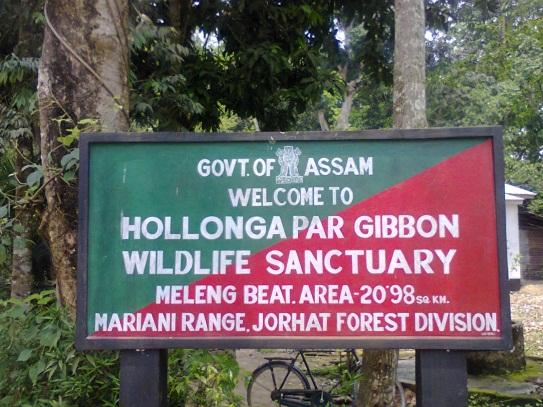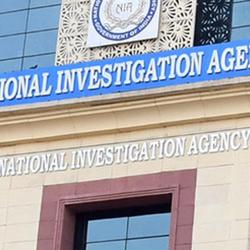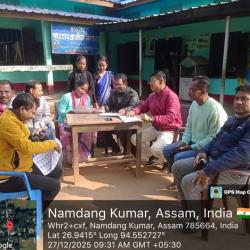There still exists a place in Mariani, Assam, a quite unknown to the world. Its known as the Hoollongapar Gibbon Sanctuary, formerly called Gibbon Wildlife Sanctuary or Hollongapar Reserve Forest. It is an isolated man-made evergreen forest located in Hoollongapar, Mariani extending as far as the foothills of the Patkai mountain range. The sanctuary was formed by the British in 188, but later on 30th July, 1997, the Government of Assam changed it into a Wildlife Sanctuary vide notification no. FRS 37/97/31 and was subsequently renamed it as the Hoollongapar Gibbon Wildlife Sanctuary.
 The Sanctuary covers about 20.98 sq. km in area. The forest has been fragmented and is surrounded by tea gardens like Chenijan, Koliapani, Meleng including human habitats. Madhpur, Lakhipur, Rampur, Velleoguri are the neighbouring villages.
The Sanctuary covers about 20.98 sq. km in area. The forest has been fragmented and is surrounded by tea gardens like Chenijan, Koliapani, Meleng including human habitats. Madhpur, Lakhipur, Rampur, Velleoguri are the neighbouring villages.
Hoollongapar Sanctuary contains India's only ape family - the Hoolock Gibbon, numbering about 106. Other primates in the sanctuary include the Stump-tailed Macaque (Henduri Bandor in Assamese) which are some 233 in number, the Pig-tailed Macaque which are left with a population of 75 only, the Capped Langur with just 162, 174 Rhesus Macaques, and the Slow Loris (Lajuki Bandor) whose estimation is yet to be made.
Beat Officer Deepak BordoloiThe Beat Officer is the Officer in charge of the Sanctuary accompanied by 24 other staff members. The guards patrol the reserve 24x7, and check posts are maintained in all four directions. Visitors are never sent alone while exploring the forest, and are always accompanied by the forest guards for safety. Mr. Deepak Bordoloi is presently posted as the Beat Officer of Hoollongapar Sanctuary. The working staff has so far had no special training to look after these rare species.
Gibbons usually never stray and are therefore not a threat to human habitats and no special method is required to contain them. Gibbons stay within their own territories and any kind of disturbance from other primates leads to fights. A unique thing about gibbons is that they choose mates from outside their immediate family.
Dr. Narayan Sharma is a primatologist from National Institute of Advanced Studies associated with the sanctuary and Dr. Dilip Shetty is another researcher who completed his post doctorate studing the sanctuary itself. The sanctuary so far has received no foreign funds.
The vegetation at the Hoollongapar Gibbon Sanctuary is evergreen in nature and comprise a variety of canopies. The upper canopy consists of trees which have straight trunks like Sam, Amari, Sopas, Bhelu, Udal and Hingori. Nahar trees dominate the middle canopy with its branches spreading and casting their shade over areas like Bandordima, Dhuna, Bhomora, Ful Gomari Bonbogi and others. A variety of the evergreen shrubs make up for the lower canopy and the ground layers. Some of them are Dolu Bamboo, Bojal Bamboo, Jengu, Jati Bet, Houka Bet, Tora, Kaupat and Sorat.
The main concern in the reserve is that the habitat is being threatened by illegal trees felling encroachment by human settlements and habitat fragmentation. Collection of large quantities of leaves and grasses from the forest bed to feed cattle poses interferences.The tea gardens are used by elephants as a corridor to Nagaland, making them vulnerable to frequent poaching. Railway lines further divide the park, stranding a single group of gibbons in a small fragment of the sanctuary.
Photographs by Arunabh Gogoi
- 13408 reads










Add new comment